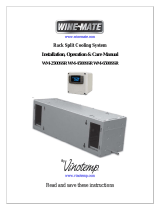
- 18 -
6. Parameter Programming
1) Press and hold the SET + keys until the “°C” or “°F” LED starts flashing,
then release the keys.
2) Press and hold again the SET + keys until the Pr2 label is displayed, then
release the keys. The first parameter Hy will be displayed.
3) Press up/down keys / to scroll to the required parameter within 10 sec.
4) Press the “SET” key to display its value.
5) Use up/down keys to change its value within 10 sec.
6) Press “SET” to store the new value and the display will flash 3 times.
7) To exit: Press SET + or wait 15sec without pressing a key.
PARAMETER DESCRIPTION DEFAULT VALUE
Set
set-point (
°)
55
Hy
temperature regulation differential (
°)
4
AC anti-short cycle delay (min) 10
Con compress on with probe faulty (min) 15
CoF compress off with probe faulty (min) 30
CF
temperature unit (
°F/ °C)
F: Fahrenheit
rES display resolution in: integer
dLy temperature display delay (min) 1
ot
probe calibration (
°)
0
LS
minimum set-point (
°)
50
US
maximum set-point (
°)
65
idF defrost cycle interval time (hour) 12
MdF defrost cycle endurance time (min) 30
ALC temperature alarm type rE: relative to set-point
ALU
high temperature alarm (
°)
10
ALL
low temperature alarm (
°)
10
AFH
alarm recovery differential (
°)
5
ALd temperature alarm delay (min) 60
dAO temperature alarm delay on startup (hr) 23
SAA
heater set-point (
°)
40
SHy
heater regulation differential (
°)
4
FSU fan action Std
FnC fan operating mode C-n: on with compressor & off during defrost
Fon fan on with compressor off (min) 0
FoF fan off with compressor off (min) 15
NOTE: Depending on the controller, not all parameters are used.
7. How to calibrate the air probe
If the actual cellar temperature differs from the setting temperature, set
parameter ot = actual cellar temperature minus set-point.
8. How to adjust defrost cycle




















